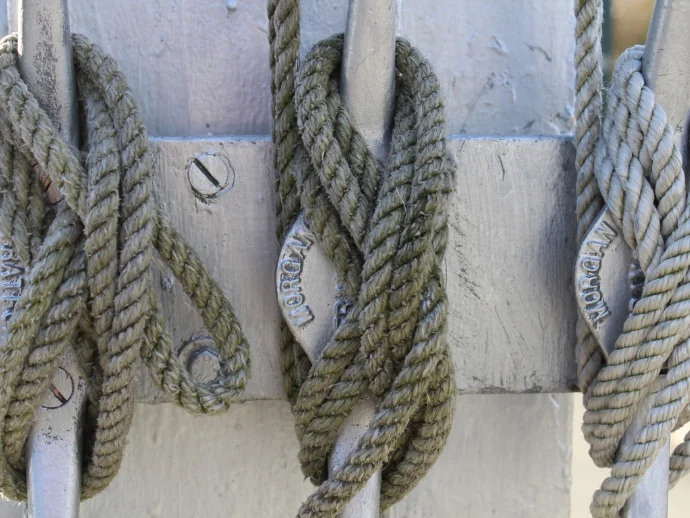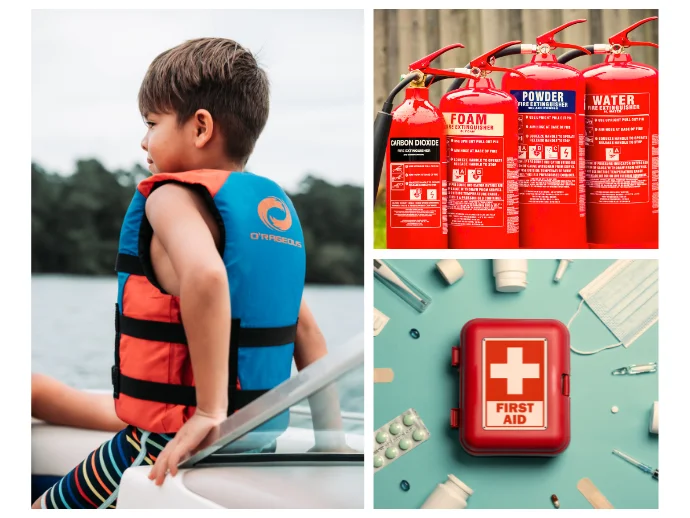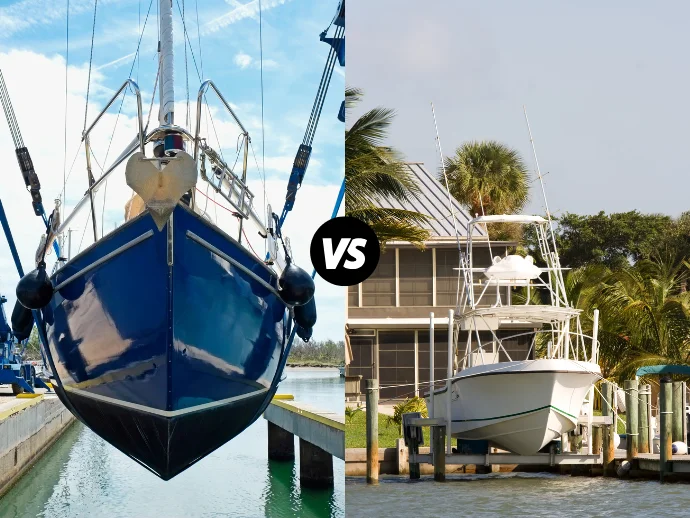
You’re at the dock, and the sun is setting. Your boat is drifting a little bit. You go for the rope… but where do you tie it?
This is where you would use a boat cleat. Easy. Safe. Required.
Boat cleats are essential in keeping your boat where it needs to be. It is safe, secure, and stationary.
In this guide, we will go over it all. What is a boat cleat? What types of cleats are there? Where to put them? How to use them?
Now let’s get started.
What is a Boat Cleat?
A boat cleat is a device attached to a boat or a dock. Its purpose is to tie ropes (or lines) quickly and securely.
Think of it as a tie-down point to secure the boat. You can tie your dock line around the cleat. This will hold your boat in place; no drifting, no damage, just control.
Most boat cleats are T-shaped or horn-shaped. This design makes it easy to wrap and secure ropes. You will find them on boats, docks, marinas, and kayaks.
Without a cleat? Good luck.
Why Are Boat Cleats So Important?
Without cleats, you’d be forced to tie lines around rails or handles, which is not safe, secure, or innovative.
Boat cleats give you:
- Control – Keep your boat from floating away.
- Safety – Avoid crashes, drifts, and tangled lines.
- Speed – Tie and untie within seconds.
- Durability – Designed to take a lot of force from waves, tides, and winds.
The Parts of a Cleat
Let’s get into specifics.
1. Horns: The two “arms” that jut out. You wrap the rope around these.
2. Base: The part on the bottom, attached to the boat or dock.
3. Mounting holes: Where the bolts or screws are to hold the cleat in place.
Some cleats have a center hole or groove to allow quick rope threading.
Types of Boat Cleats
Cleats are not all created equally. Different boats need other types of cleats. Here are the most common types you’ll encounter:
1. Horn Cleats:
The most recognisable cleat is usually shaped like a T or an anvil. It has an old-school design, is easy to operate, and works on most boats.
2. Flip-up Cleats:
Usually, you’ll have either a flip-up or a pop-up cleat. The flip-up cleat lies flat when not in use, and when you need it, it pops back up. It’s attractive and easy to stub your toe on.
3. Cam Cleats:
This type uses two spring-loaded cams to hold the rope. It is often found on sailboats. It has a quick release and is suitable for making quick line adjustments.
4. Clam Cleats:
It is rigid; you simply pull the rope into the clam’s jaws. It holds the rope securely, making it perfect for small crafts and dinghies.
5. Dock Cleats:
Kept on docks, not on boats. Massive. Heavy duty. Generally, horn-shaped.
Materials Used in Boat Cleats
You can’t just use anything. Saltwater can be rough, and the sun can be relentless. Cleats need to hold up.
Here are the typical clear materials:
1. Stainless Steel: Sturdy, Rust-free, Shiny, and Sharp-looking. The top choice in marine.
2. Aluminium is lightweight and better than steel. It won’t rust but can oxidise, which is the budget option.
3. Nylon/Plastic: Cheap, and it will not corrode. Best for small boats and also for temporary use.
4. Bronze: Old-school. Tough. You see a lot of it on old boats or in saltwater.
Select the right material based on your boat, environment, and budget.
Sizes Matter
Size is not just a strength factor, but it must also be the correct size.
Too small? Your line will slip and not hold reliably.
Too big? You are over-spec’ing and wasting line. Plus, you look like a real dork with a clunky cleat.
Generally, your cleat should be 1 inch long for every 1/16 inch of line diameter.
Example:
3/8″ rope = 6″ cleat
1/2″ rope = 8″ cleat
Follow the manufacturer’s specs and consider the load your boat will be under—wind, current, and movement.
Where to Install Boat Cleats?
1. Placement is key.
2. Put cleats where you need them, not just where they look good.
Typical spots:
- Bow (front) – For mooring or anchoring.
- Stern (back) – For docking.
- Midship (middle) – Helps with side tie-ups or spring lines.
On docks, put cleats every 10 feet or so and make sure they are easily reachable from the boat.
Pro tip: Keep them out of the walkway, but not out of reach.
How to Install a Boat Cleat?
If you are good with your hands, you can install cleats yourself.
Tools Required:
- Drill
- Screws or bolts (marine grade)
- Screwdriver or wrench
- Sealant (like 3M 5200)
- Backing plate (for additional strength)
Process:
- Mark Holes – Place the cleat down where you want to install it.
- Drill Pilot Holes – Avoid cracking by pre-drilling the holes for screws or bolts.
- Apply Sealant – To avoid water underneath the cleat, install sealant around the holes.
- Bolt it Down – If it is bolted, you must use nuts and a backing plate for inserts.
- Tighten – Need to make it snug and secure the cleats down.
Just so you know, it’s always subjective. Use a sealant to ensure it holds up under waves, wakes, and wild weather!
How to Tie a Cleat Hitch?
Your knot of choice is the cleat hitch. Here’s how to tie it:
- Wrap around the base – One complete turn under the horns.
- Figure eight – Over one horn, under the other.
- Finish with a loop – A half hitch under itself. Pull tight.
No complicated knots. No mystery. Stays tight, but unties easily. Practice it. You’ll be tying them up without thinking about it in no time.
Common Mistakes (And How to Avoid Them)
We all mess up. But when it comes to cleats, messing up can have costly consequences.
1. Wrong Size:
- Too small = useless.
- Too big = taking up unnecessary space.
2. Bad Placement: Don’t block the walkways. Or mount the cleats too far in from the edges.
3. Loose Mounting: It is always best to secure them with backing plates and sealant.
4. Bad Knots: If you tie up incorrectly, your load might drift.
5. Cheap Materials: Spend a little more for stainless steel. It’s worth it.
Boat Cleats for Different Types of Boats
- Fishing Boats: Solid horn cleats. Easy tie-downs for gear and docking, such as tying on an anchor.
- Sailboats: Cam cleats and clam cleats. Quick line adjustment under load.
- Yachts: Flush-mount or pop-up cleats. Looks excellent, serious strength and support.
- Pontoon Boats: Standard horn cleats or standard flip-ups. These cleats need to be out of the way.
- Kayaks: Little nylon cleats, or pad eyes, are great for anchoring to a specific location and holding accessories and other gear.
Choose what matches the style and purpose of your boat.
Boat Cleats and LMS (Line Management Systems)
LMS (Line Management Systems) is a hardware system that works with the cleat to keep lines organised. LMS systems can guide, store, and manage your lines.
Think rope organisers. Pulley systems. Tensioners.
A good LMS includes:
- Fairleads
- Rope bags
- Line hooks
- Cleat organisers
Want a professional finish? Use cleats and LMS together for a seamless finish.
What’s New in 2025?
Boat cleats are NOT stuck in the past.
- Smart Cleats: Newer variations, with their respective sensors, can detect tension and, in some cases, notify your smartphone if a line comes free.
- Eco-Friendly Materials: Recycled plastics and bio-metals lessen the environmental footprint.
- Tool-Free Installs: Quick-mount cleats snap in, require no drilling or sealant, and are perfect for small boats.
- Modular Cleats: You can build accessories on these – fenders, rod holders, etc, even cup holders!
Final Thoughts
So, what is a boat cleat? It’s more than just a piece of hardware. Knowing your boat is where it should be is peace of mind. It makes docking easier. It helps you manage every line and every movement. Every ship, big or small, needs cleats. Now you know what they are, how they work, and how to choose the right one. The next time you dock, you won’t be left wondering what to do. You’ll know exactly where the rope goes, right around the cleat.



